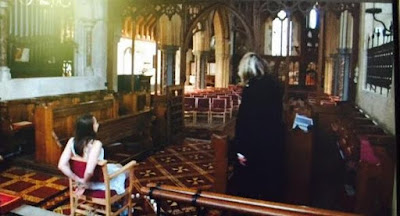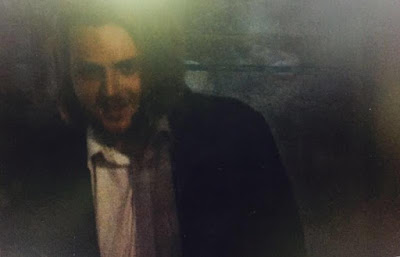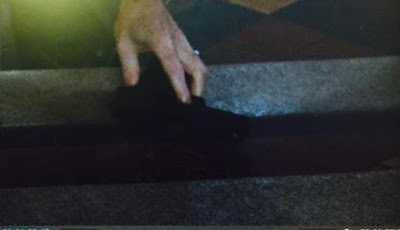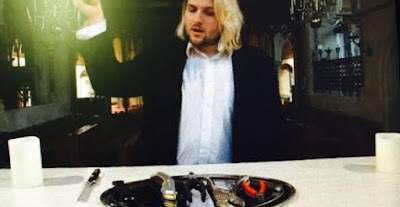How does your media product represent particular social groups?
The target audience for our Thriller would be 15-20-year-old males. We have taken this into consideration and ensured that our sequence represents particular social groups, particularly focusing on age and gender that will appeal to our target audience.
We decided that the victim of the thriller would be dressed in a white dress. The use of the colour white connoted that she was innocent and pure and therefore made the audience sympathise with her more as she was automatically the weaker character. This costume choice showed that our sequence was adhering to the stereotype of females being weaker than males and in particular, younger characters being weaker than the older characters.
We had the psychopath (villain) dressed in a white shirt and a black coat and black trousers. The white here was a juxtaposition to the evil, powerful character of the psychopath. His charter wore white to juxtapose the fact that he was no longer pure. In wearing white, the psychopath was then directly contrasted to the hero of the sequence, the policeman.
The policeman had a similar costume to the psychopath, however he had a neatly ironed shirt and wore a dark tie. This set him apart from the other two characters as it gave connotations of power and authority. This costume makes the audience feel comfortable and secure with this character and makes them instantly trust him.
The victim is sitting down at the start of the sequence. This clearly shows the audience the fact that she is powerless because she is physically below the psychopath. Having her sitting down not only makes her appear smaller but also weaker because as she is tied to the chair, she has no escape. The audience therefore sympathises with her because she is the weakest character and it appears that she has no escape. FACIAL EXPRESSIONS
Further on in the sequence the victim is held back by the psychopath with a tool to her mouth. This shot makes her appear even more powerless as the psychopath is the one in control. This further emphasises the victim’s vulnerability and enhances fear for the audience as they are unsure of what the psychopath is going to do to the girl. This adheres to the stereotype of females being weaker than males and also gives the impression that people in middle age (20-30) are wreck less and irresponsible. FACIAL EXPRESSIONS
Through his facial expressions, the policeman is shown to be in control and powerful. He has the most serious facial expressions but he also doesn’t look immediately concerned, which suggests to the audience that he has been in this situation before. Later on, at the end of the sequence, he sees the psychopath’s reaction to the girl stabbing him and he looks more concerned. This change in facial expressions highlights for the audience that this is not what he was expecting and so warns them that they should be worried.
The first shot of the sequence is a close up of the victim. This shot makes her appear vulnerable and adheres to the stereotype of females being weak. As this is the first character that the audience see, we automatically side with her and sympathise with her. This encourages the audience to support this character and although she may be the victim, she is the central character in the sequence. Having a close up as the first shot is very intimate and means that the audience feel closer to the victim. This shot also enables them to see her panicked and pained facial expressions making them sympathise with her even more.
The first shot that we see of the psychopath is a close up high angle. As he is walking up a staircase, he is coming towards the camera, making him appear more threatening. This gives the audience a negative impression of the character and unlike the victim, we do not trust him.
Furthermore, there is a mid-shot of the psychopath cutting his tongue with a knife which adheres to the stereotype of young adults being irresponsible and untrustworthy. Seeing this shocks the audience and makes them question him as a character. A mid sot also means that the audience are able to see more of his body, making him more powerful and threatening.
At the end of the sequence, when the victim is saved, there is a mid-shot of her and the policeman/inspector. This shot shows that she needs to be saved by a man and so adheres to the stereotype that women are weaker than men.
As we were in a church, the acoustics were noticeably different to how they are in a normal setting. This echo that was produced by talking in a church gave a more creepy and eerie atmosphere to the sequence and makes the audience feel more uncomfortable because it is not a sound that they are used to.
At the start of the sequence, the psychopath is singing. This out of place, happy Christmas song makes the audience more uncomfortable as it is not something that you would associate with the horrible situation that is going on. This diegetic sound makes the audience uncomfortable because that is all that can be heard in the church. The juxtaposition of a happy song and a terrifying event makes the audience even more uncomfortable and uneasy because they are unsure of what will happen next.
The diegetic dialogue in this scene is what helps the audience to understand the narrative but at the same time doesn’t give much away. From this dialogue, it is implied that this psychopath has done things like this before and it is also assumed that he is very dangerous because “the place is surrounded”. The psychopath uses a very light and unfazed tone when he says anything, which puts the audience on edge because the fact that he is so calm in this situation is usual and something that you would not expect. The policeman uses a very serious tone when he speaks which highlights the importance of the situation and the danger that the psychopath may cause. The policeman’s serious yet calm tone also indicates to the audience that he has been in this situation before and so they trust him as they believe that he knows how to handle the situation. The victim doesn’t have any dialogue in the scene. This highlights that she is the weakest character and cold also shoe the sequence adhering to the stereotype that females are weaker than males. It also reinforced the idea that younger teenagers are naïve and often unaware of what is going on. It could also be suggested that the fact she doesn’t have any dialogue is because she is too afraid to speak, and it would be difficult to say anything as her mouth is taped. This therefore makes the audience sympathise with her more as she is helpless.
The use of the diegetic sound of the knife when the girl stabs the psychopath is a climactic moment for the audience. This sound of the knife is very harsh and brutal and so grabs the audience’s attention. This diegetic sound also highlights to the audience the sudden change that has happened in the scene and changes the slow and calm pace to more frantic and action packed. This sound is very noticeable to the audience because up to this point, the sequence has been very slow and quiet. The sound also represents a sudden change in the victim’s character as she has changed from weak to strong, making the audience support her even more. Most importantly, this sound effect helps the stab to look more realistic for the audience and helps them to believe that she has actually stabbed the psychopath.
The non-diegetic soundtrack we used added an element of atmosphere and fear that was missing. Using a soundtrack indicated to the audience when there were moments of high tension. The non-diegetic soundtrack adds another level to the sequence and creates a more sinister mood to the scene. This soundtrack therefore makes the audience feel more uncomfortable and tense as they are anticipating something happening.
As we filmed in a church, we had to rely mainly on natural light. This gave a tenser and thrilling atmosphere to our sequence as there were certain areas within the church with a lot of natural light but other places where there was very minimal light. For example, the psychopath begins the sequence in a stairwell which is very dark with only a window of light shining through. This lighting was particularly effective because the audience can only just make out his features, making him more mysterious and threatening.
We decided that we would edit the sequence in a linear order. This makes the scene easier to follow but also makes the audience feel as if they are there and things are being revealed to them at the same time that they are revealed to the characters.
We used short shot durations throughout the sequence to keep the scene fast paced and action filled, causing the audience to feel even more tense and on edge. This makes them expectant that something will happen but also keeps it engaging. Not all of the shots were short. Some were longer to contrast but to also make the audience feel more uncomfortable. For example, when the psychopath holds back the victim’s head. The shot is a just a bot longer than you would want it to be, making the audience feel uneasy and tense.
We used the shortest shot duration when the victim stabs the psychopath. When editing, we sped up the clip to make it seem as realistic as possible and to show that it is a moment of high intensity and action. Doing this made it look more realistic for the audience and made it more shocking as they only see it for a second. This is the point in the sequence when the victim subverts the stereotypes that she had earlier on in the sequence, she suddenly changes from the weakest character to the strongest character in a matter of seconds. Having such a short shot duration also emphasises how unexpected it is.
We used eye line match throughout the sequence which adds an element of mystery to the scene. For example, the audience first see what the victim’s reaction is and then it is revealed what she is reacting to. This keeps them guessing for longer but also means that they have already formed an opinion about whether what she is seeing is bad or good before they have seen it. It is also important that we see the victim’s reaction first because she is the main character and so it is important that we can see what everything looks like from her perspective.
Match on action is used within the sequence to show the audience that the policeman has a gun. This indicates to them that he has been in this situation before and therefore knows how to handle it. The fact that he puts the gun down also indicates to the audience that this is a high danger situation and so they feel more tense because they are aware that the psychopath can be very dangerous.
 The use of props in the scene highlight the danger of the situation. The audience immediately see that the girl is a victim as her mouth is taped and she is tied to a chair. This adheres to the stereotype that females are weaker than males and because we can easily see that she is young, it adheres to the stereotype of younger people being more naïve.
The use of props in the scene highlight the danger of the situation. The audience immediately see that the girl is a victim as her mouth is taped and she is tied to a chair. This adheres to the stereotype that females are weaker than males and because we can easily see that she is young, it adheres to the stereotype of younger people being more naïve.The torture instruments on the altar also emphasise that the psychopath has the power to really hurt the girl and so the audience immediately feel panicked and expectant that something will happen to her. This also gives the impression that he is prepared and so has done this before.
Overall, our product uses the different areas of film-making (editing, sound, mise-en-scene and camera) to represent the thriller to our target audience. It focuses specifically on age and gender to convey to the audience the message of our thriller.












Excellent use of pictures to make this not only an illustrated essay, but also in using them to explain the points you are making about representation throughout. Well done! This a very detailed post that explores all four technical areas in great detail and how they have constructed a representation of a social group, in this case age and gender. Though don’t forget to include this within your introduction to make this clear throughout the post. You explore all four technical areas in great detail and clearly understand how you have represented your chosen social group well done. An excellent post with great use of terminology throughout. To develop your post further consider adding a conclusion to your post to summarise your detailed illustrated essay.
ReplyDelete